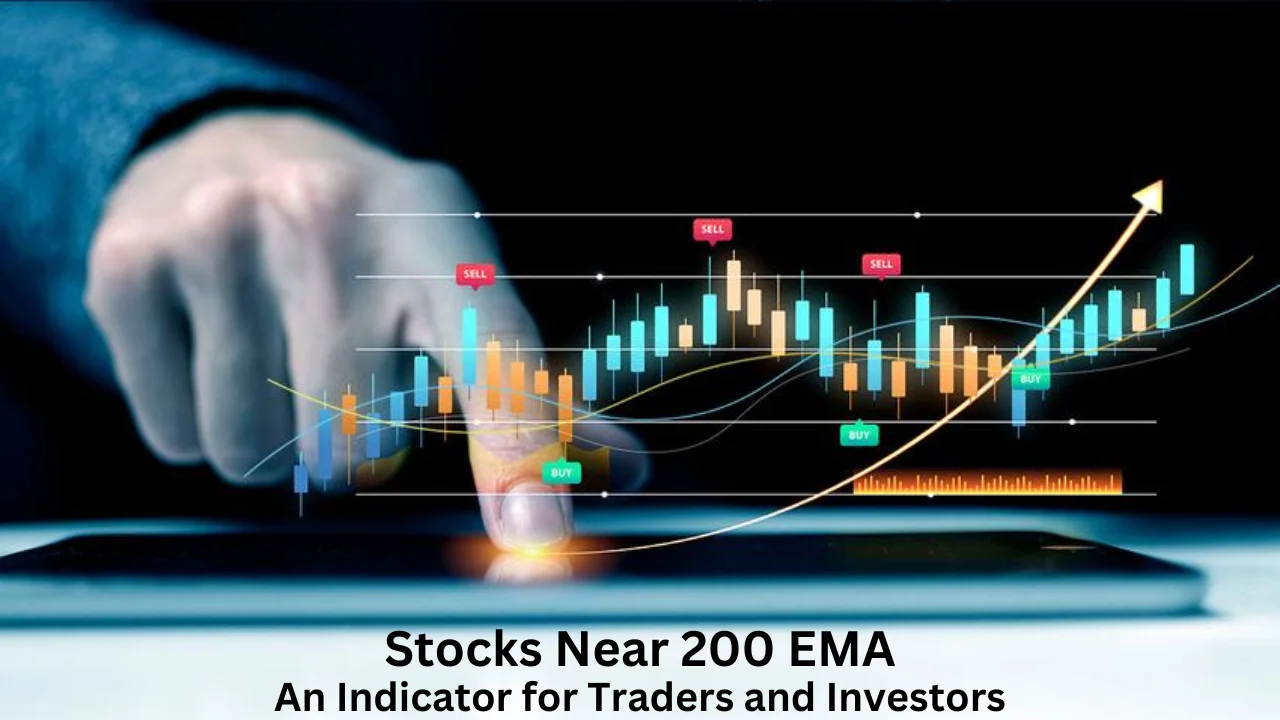Investing in the stock market can often seem like navigating through a maze. One of the tools that experienced traders use to simplify this process is the 200-day Exponential Moving Average (EMA). If you’re new to the concept, understanding what stocks near 200 EMA means can provide you with valuable insights for making informed trading decisions.
What is Stocks near 200 EMA?
Stocks near the 200 EMA refer to stocks trading close to their 200-day Exponential Moving Average, a key technical indicator that shows the long-term trend. When a stock is near this level, it often acts as a crucial support or resistance point. Stocks trading above the 200 EMA are typically in an uptrend, while those below it may indicate a downtrend. Traders and investors monitor this level to identify potential trend reversals or to confirm the continuation of a trend, making it a significant marker for buy or sell decisions.
Why the 200 EMA Matters
The 200 EMA is one of the most commonly used indicators in stock trading, and for good reason. It provides traders with a broad view of the stock’s overall trend. When a stock is trading above its 200 EMA, it is generally considered to be in a long-term uptrend. Conversely, if the stock is trading below the 200 EMA, it could signal a downtrend.
Why does this matter? Because identifying the trend of a stock is crucial for making buy or sell decisions. For example, if a stock is trading above the 200 EMA and then begins to fall toward it, traders might view this as a signal to take profits or place stop-loss orders. On the other hand, if a stock that has been trading below its 200 EMA starts to move up toward it, this could be seen as a sign of a potential reversal and an opportunity to buy.
Read Also: Crypto Pur Free Recharge: The Future of Mobile Payments
Using Stocks Near 200 EMA for Trading Decisions
Traders often use stocks near 200 EMA as a key component of their technical analysis. When a stock approaches its 200 EMA, it tends to react in one of two ways: it either bounces off this level (indicating support or resistance) or it breaks through it, signaling a potential shift in the trend.
However, if the stock breaks below the 200 EMA, it could signal a more significant trend reversal. In this case, traders might decide to sell their positions or short the stock in anticipation of further declines. This is why stocks near the 200 EMA are often considered to be at critical junctures.
Features of Stocks Near 200 EMA
Key Support and Resistance Level
One of the most significant features of stocks near 200 EMA is their tendency to find strong support or resistance at this level. For stocks trading above the 200 EMA, this indicator often acts as a support level, meaning that when the stock price approaches the EMA, it may “bounce” off this level and resume its upward trend. Conversely, for stocks trading below the 200 EMA, the indicator often acts as resistance. If a stock price approaches the 200 EMA from below, it may struggle to break above it, signaling that the downtrend may continue.
Indication of Long-Term Trend
Another key feature of stocks near 200 EMA is that it indicates the overall long-term trend of a stock. The 200 EMA provides insight into whether a stock is in an uptrend or downtrend by comparing its current price to the 200-day moving average.
Above the 200 EMA: If the stock price is above the 200 EMA, it is generally considered to be in a long-term uptrend. Investors may see this as a sign of strength, especially if the stock has been consistently above the 200 EMA for a significant period.
Below the 200 EMA: If the stock price is below the 200 EMA, it is often viewed as being in a downtrend, which may indicate weakness or bearish sentiment in the market.
Potential Trend Reversal Signal
When stocks are near their 200 EMA, they are often at a potential turning point. This is because the 200 EMA serves as a marker for long-term price action, and any deviation from it can signal a change in the overall trend. For instance, if a stock that has been trading above its 200 EMA suddenly falls below this level, it may indicate that the stock is entering a new downtrend. Conversely, if a stock that has been trading below its 200 EMA moves above it, this could signal a reversal to an uptrend.
These potential trend reversals are often closely watched by traders, as they can represent critical buy or sell signals. By understanding how a stock reacts near the 200 EMA, traders can position themselves to capitalize on these reversals.

Volatility Around the 200 EMA
Stocks near their 200 EMA often experience increased volatility, as traders and algorithms monitor this level closely. When the stock price approaches the 200 EMA, there may be a surge in buying or selling activity as traders try to anticipate whether the stock will bounce off the EMA or break through it.
This volatility can create opportunities for short-term traders to profit from price fluctuations. However, it also means that investors need to be cautious, as price swings can be more pronounced when a stock is near its 200 EMA. The increased activity around the 200 EMA often results in sharper movements, especially if the stock has been consolidating around this level for some time.
Influence on Trading Algorithms
Many trading algorithms are programmed to react to certain technical indicators, and the 200 EMA is one of the most commonly used indicators in algorithmic trading. This means that stocks near their 200 EMA can experience significant trading volume as automated systems trigger buy or sell orders based on the stock’s proximity to the 200 EMA.
The influence of these algorithms can create sudden price movements, as large buy or sell orders are executed when the stock crosses the 200 EMA. This is another reason why stocks near 200 EMA can be more volatile compared to stocks further away from their 200 EMA.
Psychological Importance for Traders and Investors
The 200 EMA carries psychological significance for many market participants. Traders and investors alike view the 200 EMA as a “line in the sand” that separates bullish sentiment from bearish sentiment. When a stock is above the 200 EMA, it is often. Considered strong, and when it is below, it may be. Viewed as weak.
This psychological factor can influence trading decisions, as traders often act based on their perception of whether the stock is in a bullish or bearish phase. The 200 EMA, being a well-established long-term indicator, is frequently. Used to gauge market sentiment.
Dynamic Nature of the 200 EMA
Unlike fixed support or resistance levels, the 200 EMA is a dynamic indicator. It moves in response to changes in the stock’s price, which allows it to adjust to new market conditions. This makes the 200 EMA more flexible and accurate in representing the stock’s current trend compared to static indicators like previous highs or lows.
Because the 200 EMA adapts to changing prices, it provides a more reliable indication of the stock’s long-term direction. As the stock price moves, the 200 EMA moves with it, offering traders and investors a real-time view of the stock’s overall trend.
Widely Used in Multiple Market Conditions
One of the standout features of the 200 EMA is its versatility. Whether the market is trending upward, downward, or moving sideways, the 200 EMA remains a valuable tool. In bullish markets, stocks near the 200 EMA can be. Seen as opportunities for continuation trades, where traders expect the price to bounce off the 200 EMA and move higher.
In bearish markets, stocks near the 200 EMA can be. Seen as potential shorting opportunities, especially if the stock is approaching the EMA from below and facing resistance. Even in sideways markets, the 200 EMA can act as a pivot point where the stock oscillates between support and resistance, providing multiple trading opportunities.
Read Also: The Rise of Bitcoin Gift Cards in 2024
Comparison of stocks near 200 EMA and with their competitors
| Stock Name | Current Price | 200 EMA | Price vs 200 EMA | Competitor Stock | Competitor’s Price vs 200 EMA |
|---|---|---|---|---|---|
| Apple (AAPL) | $175 | $170 | 2.94% Above | Microsoft (MSFT) | 3.25% Above |
| Tesla (TSLA) | $245 | $240 | 2.08% Above | Rivian (RIVN) | 5.60% Below |
| Amazon (AMZN) | $135 | $133 | 1.50% Above | Alibaba (BABA) | 8.20% Below |
| Nvidia (NVDA) | $450 | $425 | 5.88% Above | AMD (AMD) | 4.40% Above |
| Google (GOOGL) | $135 | $132 | 2.27% Above | Meta (META) | 1.80% Above |
| ExxonMobil (XOM) | $120 | $123 | 2.44% Below | Chevron (CVX) | 1.75% Below |
A Closer Look at Stocks Near 200 EMA
To better understand how stocks near 200 EMA perform, let’s take a look at an example. Consider Stock A, which has been trading at $50 for several months and is well above its 200 EMA of $45. If Stock A begins to decline and approaches the $45 level, traders will watch closely. If it bounces off this level, it could be a good opportunity to buy, anticipating that the stock will resume its uptrend.
| Stock Name | Current Price | 200 EMA Level | Trend |
|---|---|---|---|
| Stock A | $50 | $45 | Uptrend |
| Stock B | $40 | $42 | Downtrend |
| Stock C | $47 | $47.5 | Near EMA |
Frequently Asked Questions
What does it mean when a stock is near its 200 EMA?
When a stock is near its 200-day Exponential Moving Average (EMA), it indicates a key support or resistance level. It can signal a potential trend reversal or confirmation, depending on whether the stock breaks through or bounces off the 200 EMA.
Is it a good time to buy when a stock is near its 200 EMA?
Buying near the 200 EMA can be a good opportunity if the stock finds support and moves upward. However, if the stock breaks below the 200 EMA, it could signal a downtrend, so it’s important to analyze other indicators as well.
How reliable is the 200 EMA for predicting stock trends?
The 200 EMA is widely. Regarded as a reliable long-term trend indicator. While it offers a strong indication of the overall direction, it should be. Used with other technical indicators to make well-informed decisions.
What happens if a stock breaks below the 200 EMA?
If a stock breaks below the 200 EMA, it often signals a potential shift from a bullish to a bearish trend. Traders may interpret this as a sign to sell or short the stock, anticipating further downward movement.
Conclusion
When it comes to analyzing the stock market, the 200 EMA is a powerful tool that helps traders and investors identify key turning points. Stocks near 200 EMA are particularly important because they represent a critical point where the stock’s trend may either continue or reverse.
Understanding the significance of this indicator can help you make more informed decisions and potentially improve your trading results. Whether you are a short-term trader looking for entry and exit points or a long-term investor seeking to understand the broader market trend, the 200 EMA should be a key part of your technical analysis toolkit.

